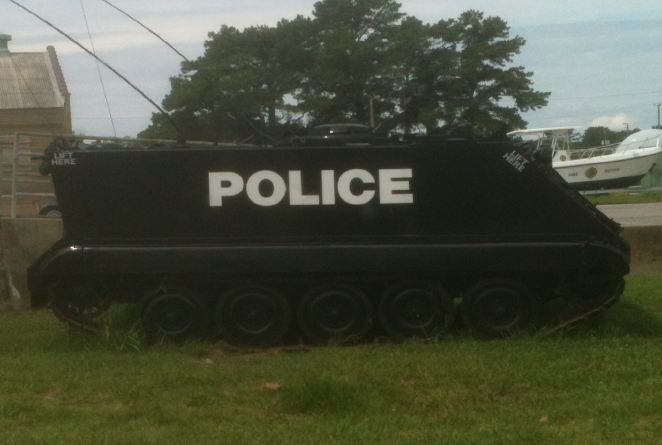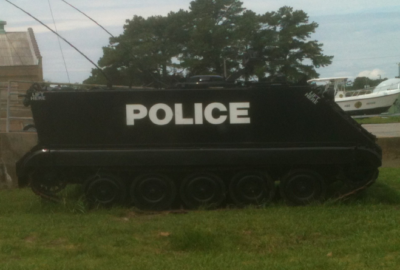
Investigation: Navy shipyard wasted $21 million building off-the-books police force
An investigation by Naval Sea Systems Command found employees at the nation's largest Navy shipyard spent 12 years amassing weapons, vehicles and boats, building...
Editor’s Note: A previous version of this story reported that military criminal investigators declined to pursue the case. The Naval Criminal Investigative Service initially investigated the matter in 2014, but federal prosecutors declined to file charges.
For the better part of a dozen years, a group of employees and managers at the Navy’s largest public shipyard operated what amounted to an unsanctioned, off-the-books police force, equipping it with illegally or improperly obtained weapons, vehicles and fuel, wasting an estimated $21 million in public funds in the process.
Those are the findings of an internal command-directed investigation performed by the Naval Sea Systems Command’s inspector general, which undertook an in-depth review of the case after federal prosecutors declined to file criminal charges.
The investigation, which was conducted in 2014, has not been previously disclosed. But to date, none of the shipyard officials involved in the enterprise have faced punishment or prosecution, partly because most of them opted to retire before the investigation began, and millions of dollars in unaccounted-for property remains missing.
The case has its origins, investigators say, in the aftermath of the Sept. 11 attacks, when agencies were flush with cash to spend on improving their security and few were inclined to question any spending that was ostensibly intended to protect federal facilities and employees.
In that environment, the officials in charge of a group of unarmed security guards, whose job was supposed to be patrolling the shipyard’s internal work areas, began beefing up the workforce and outfitting it with firearms, boats, law enforcement badges, vehicles (complete with fictitious license plates) and an armored personnel carrier that they emblazoned with the word “police.”
“These folks are not law enforcement, but they wanted to be, and all of their actions were done to become a law enforcement organization,” said Peter Lintner, the deputy director of investigations at NAVSEA. “The stunning thing is that this happened over the course of seven commanding officers, and not a single one of them put a stop to it or really even had any visibility on it. Everybody just thought, ‘Well, they’re the good guys. They’re the security department. They’re not going to do anything wrong.’ In actuality, they were doing everything wrong, and they knew it.”
Lintner, who said the investigation originated from whistleblower tips to an inspector general hotline, described the case in detail during a recent governmentwide gathering of hotline officials organized by the Defense Department’s inspector general. He did not specify which shipyard was involved, but materials gathered by investigators make clear that the facility in question is Norfolk Naval Shipyard in Portsmouth, Va.
Stocked with illegal weapons
The investigation found that the establishment of the unauthorized law enforcement agency at the Norfolk shipyard was wrong on its face, because Navy regulations only allow one armed police force on any base — in this case, the Navy Police Department operated by the mid-Atlantic region of Navy Installations Command. To let any other group of workers carry weapons and perform law enforcement functions takes special permission from the Chief of Naval Operations, permission the security specialists neither requested nor received.
Nonetheless, they created their own on-base armory and stocked it with “illegally” purchased Berettas, thousands of rounds of ammunition, high-powered rifle scopes, night vision goggles and ballistic vests and helmets.
And to acquire a new fleet of vehicles, employees turned to a surplus property yard operated by the Defense Logistics Agency a few miles down the road, the investigation found.
Procedures in place at the time that have since been tightened up, according to Lintner, let virtually any government employee shop through a lot of used Suburbans, Humvees and other vehicles, and drive off with one after presenting a letter of authorization from a supervisor and completing roughly 30 minutes of paperwork.
In that way, the security specialists allegedly obtained at least 92 vehicles and other equipment worth more than $4 million without any valid mission requirement — including a flatbed tractor-trailer to move the vehicles around. To this day, all of that property is unaccounted for, according to the IG’s office.
But the way in which the group procured the vehicles also presented a problem for them.
Navy regulations require all of the service’s government vehicles to be acquired and registered through Naval Facilities and Engineering Command. NAVFAC refused to sanction the ones the security specialists obtained through DLA’s surplus lot, and advised them to send them back.
License plate workaround
Lintner says the group quickly found a workaround.
“The security department said, ‘Roger that,’ and then developed a license plate manufacturing plant in the shipyard, made their own plates and put those on the vehicles,” he said. “We also found boxes full of expired license plates that they had taken off of vehicles at DLA. Whenever they wanted to use a vehicle, they just slapped one on and off they went.”
That plan seems to have worked just fine until several of the Norfolk employees used one of the vehicles to travel to a course at the Federal Law Enforcement Training Center (FLETC) in Georgia — part of $66,000 in police training the IG says was totally unjustified, considering the employees’ official positions as security specialists.
“When they got to the gate at FLETC, they were denied entrance because the plates weren’t any good — they’d made their own,” Lintner said. “So their solution was to back around the corner, put another valid government plate on from another vehicle, and they drove it right into FLETC.”
Gasoline presented another potential hurdle, since there was no clear way to finance and account for the fueling of vehicles the Navy didn’t technically own. But again, the security team found a solution. The shipyard had a valid work order with a fuel delivery company that regularly visited the base to replenish the yard’s gasoline-powered lighting devices, so the employees allegedly got the tanker trunk driver to also top off their vehicle fleet’s gas tanks on every visit.
Investigators said apart from the ways in which the employees acquired their vehicles, the fact and the ways in which they operated them on public roadways presented major liability concerns for the government.
For instance, at times, the employees would turn on unauthorized lights and sirens they had installed on the vehicles themselves to perform traditional law enforcement duties, like responding to traffic accidents on public roads.
And the fleet the security specialists amassed included not just Suburbans, Tahoes and Humvees, but heavy-duty equipment whose operators are supposed to have special licenses, including at least two tractor trailers, a backhoe, and a large bus that the team outfitted with $233,000 in communications equipment for use as a mobile incident command center (it was never actually used for that purpose). The IG says not only were the vehicles not properly licensed, neither were their drivers. And needless to say, none of the unregistered vehicles were insured.
$150,000 for a high-speed boat
The IG pointed to similar issues with the fleet of boats the team acquired, again, according to investigators, without any valid mission requirement. One such vessel — a high-speed interdiction boat — was bought for $150,000 with a government purchase card, and the team paid at least $206,000 more to tie it up at a nearby private marina instead of at the shipyard itself, where there was abundant dock space for small boats.
The team did apparently, on one occasion, use the interdiction boat to catch up with a jet skier who had intruded onto the base, but Lintner said that episode alone could have been a “disaster” for the government if something had gone wrong, because neither the interdiction vessel nor its operator was properly registered or licensed with the Coast Guard.
The Norfolk employees appear to have gone out of their way to conceal the equipment they had amassed from installation officials who were responsible for performing property inventories and anyone else on the base. To keep the armored personnel carrier hidden, they erected plastic barriers and a hedge surrounded by concertina wire, the investigation found. Ordinarily, they housed many of their vehicles inside an enormous warehouse on a remote edge of the compound.
But when they learned that the base’s asset manager was scheduled to visit the warehouse to check to see what was inside, they worked quickly to temporarily empty it.
Latest Defense News
“They drove all the vehicles out, loaded everything on the flatbed and stashed it in one of the back parking lots on the local naval base,” Lintner said. “When the asset manager got there it was literally an empty warehouse, but the day before it had been packed full of tools, vehicles, all types of material. They admitted they hid it deliberately. That’s what they said every time: ‘If anybody found out what we had, they would have taken it away from us and we wanted to be ready for any contingency.’ Their motto was, ‘It’s better to have it and not need it than need it and not have it.’”
The security employees also kept what the IG estimated to be an additional $4 million in “minor” and “sub-minor property” in various locations around the base.
“None of that stuff is on an inventory, and it’s all highly-pilferable things,” Lintner said. “These are high-cost tools, night vision goggles, sniper scopes, and there was no accountability for any of it — it was literally spread throughout the shipyard. We were crawling through snake-infested fields to get into boxes where they had some of this stuff stashed. They had it in attics and basements. Anyplace where they could find to squirrel some of this stuff away, that’s where they put it.”
Lintner said the team’s activities were enabled by virtually nonexistent oversight. The shipyard’s security director during most of the episode was given carte blanche to approve an annual budget that at one point reached $20 million, and rarely questioned the workgroup’s spending.
‘Handed out like candy’
But many of the investigators’ most serious concerns happened between 2009 and 2013, when the base hired a new deputy security director.
The IG findings say that’s the timeframe in which most of the weapons purchases occurred, and the organization made several other highly-questionable buys, including federal law enforcement badges costing several hundreds of dollars each and 1,000 challenge coins which employees “handed out like candy.”
Also in that period, the shipyard’s security workforce began to balloon and its labor costs began to skyrocket. In 2009, its payroll cost the Navy $2.6 million; that figure grew to $4.7 million by 2014.
“That’s the time where you start to see abuse of authority and preferential treatment,” Lintner said. “That’s when the big hiring glut started, but he wasn’t hiring security specialists. They were hiring friends from church, family friends, family members. None of the folks had a security specialist background, but there were a lot of folks with backgrounds as auxiliary police and auxiliary sheriffs, because he was trying to build up a police department. But unfortunately, there’s a big difference between what security specialists do and what police do.”
Overall, the IG estimated the enterprise spent $10.6 million on labor that had nothing to do with the security office’s mission and another $10.4 million on unnecessary law enforcement equipment.
Thus far, none of that money nor the missing vehicles and equipment has been recovered, and neither the Naval Criminal Investigative Service nor the U.S. Attorney has shown much of an interest in pursuing the case, Lintner said.
NAVSEA did not respond to questions from Federal News Radio about any actions the command has taken to improve oversight or any disciplinary action it has taken against workers who are still employed there, but Lintner said some employees who are still with the government had received letters of reprimand.
“The issue with this is that most of the senior folks — the commanding officer at the time, the executive director, the security director and deputy director, the director of the shipyard — all retired, in some cases before they wanted to because they were afraid this was going to go to NCIS,” he said. “We asked if we could go after those folks in retirement and we were told it’s just too hard to do. I’ve been told that some of these folks have tried to get back into the security world after they retired and discovered that the word had been put out that they weren’t trustworthy, and none of them have been able to get jobs in security, as far as we know. So apparently somebody’s keeping track of them. But there’s no recoupment of money, nobody’s out searching for the vehicles that disappeared. That’s not happening.”
Copyright © 2025 Federal News Network. All rights reserved. This website is not intended for users located within the European Economic Area.
Jared Serbu is deputy editor of Federal News Network and reports on the Defense Department’s contracting, legislative, workforce and IT issues.
Follow @jserbuWFED







